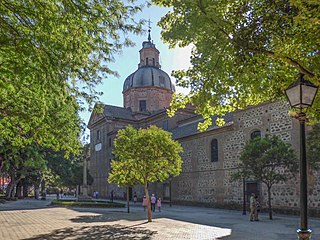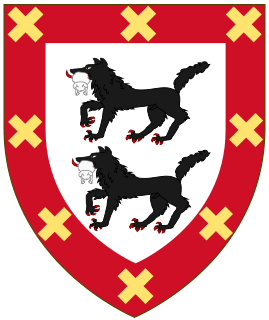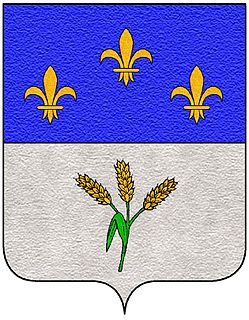Related Research Articles

Alfonso XI, called the Avenger, was the king of Castile, León and Galicia. He was the son of Ferdinand IV of Castile and his wife Constance of Portugal. Upon his father's death in 1312, several disputes ensued over who would hold regency, which were resolved in 1313.

Talavera de la Reina is a city and municipality of Spain, part of the autonomous community of Castile–La Mancha. Its population of 83,303 makes it the second most populated municipality of the province of Toledo and the fourth largest in the region.

José Emilio Pacheco Berny

The municipalities or municipios of El Salvador correspond to the second level administrative division in the Republic of El Salvador which divide its departments. El Salvador contains 262 municipalities.
Late Basquisation is the minority hypothesis that dates the arrival of the first Basque-speakers in north-eastern Iberia from Aquitaine to the 5th or 6th century AD.

The Lordship of Biscay was a region under feudal rule in the region of Biscay in the Iberian Peninsula between c.1040 and 1876, ruled by a political figure known as the Lord of Biscay. One of the Basque señoríos, it was a territory with its own political organization, with its own naval ensign, consulate in Bruges and customs offices in Balmaseda and Urduña, from the 11th Century until 1876, when the Juntas Generales were abolished. Since 1379, when John I of Castile became the Lord of Biscay, the lordship got integrated into the Crown of Castile, and eventually the Kingdom of Spain.

John of Castile, called the "el de Tarifa" was an infante of Castile and León. He was engaged in a decades long fight for control over the Lordship of Biscay with Diego López V de Haro, the uncle of his wife.
Julio Valdeón Baruque was a historian of Spain.

Lope Díaz de Haro was a Spanish noble of the House of Haro, the traditional Lords of Biscay. He was the firstborn son of Diego Lopez V de Haro, Lord of Biscay. Whilst he did not inherit his father's title of Lordship over Biscay, he is best known for being the lord of Orduña-Urduña and of Balmaseda. He further served as Alférez to King Ferdinand IV of Castile.
Alcalde ordinario refers to the judicial and administrative officials in the cabildos in the Spanish Viceroyalties in the Americas during the times of the Spanish Empire in the 16th through 19th centuries Spanish West Indies Empire. Always existing in pairs, they were called Alcalde de primer voto and Alcaldes de segundo voto. The alcalde ordinario was a judicial magistrate who, with some exceptions, was responsible for the administration of civil and criminal justice within their municipal jurisdiction.
João Afonso de Albuquerque,, Juan Alfonso de Alburquerque in Spanish and nicknamed "o do Ataúde", 6th Lord of Alburquerque, was a member of the highest ranks of the nobility of the Kingdom of Portugal, an astute politician, and descendant from the royal houses of both Portugal and Castile, although through illegitimate lines.

Enrique Enríquez the Younger was a nobleman of Castile, son of Enrique Enríquez the Elder. He was lord of Villalba de los Barros, Nogales, Almendral, La Parra, Begíjar and other towns. He was Adelantado Mayor of the border of Andalusia, chief justice of the King's House, Chief of the forces of the bishopric and Kingdom of Jaén, Mayor of Seville and Knight of the Band.

Enrique Enríquez the Elder was a nobleman of Castile, natural son of the Infante Henry of Castile. He was Lord of La Puebla de los Infantes. His son, Enrique Enríquez the Younger, had a distinguished career serving kings Alfonso XI of Castile and Peter of Castile.
Casimiro Alegre (1741–1825) was an Argentine politician and military man, who had an outstanding participation during the Viceroyalty of Peru and Viceroyalty of the Río de la Plata, serving as alcalde of campaign in the Province of Buenos Aires, and as Commandant in the Regiment of Blandengues of the Frontier of Buenos Aires.

Joseph Gregorio Belgrano (1762–1823) was an Argentine military officer and politician. His brother was the General Manuel Belgrano, member of the Primera Junta and hero in Argentine War of Independence.

Juan Gutiérrez de Gualda was a priest and mathematician known to be the author of a popular book on arithmetic.

The House of Traba, sometimes called the Fróilaz-Traba, was a Galician noble family of the high Middle Ages. The family can be traced back to the eleventh century. They are associated with a castle named Traba, probably in the county of Bergantiños, and also with the county of Trastámara.
The concejo abierto is the regime under which the local government of some small Spanish municipalities operate. A case of direct democracy, the system allows for the existence of two bodies: the Mayor and the asamblea vecinal, also known as concejo, formed by the all the electors of the municipality. It is also used by other entities below the municipal level.
Eduardo González Calleja is a Spanish historian, professor of Contemporary History at the Charles III University of Madrid (UC3M). He is the author of a long list of scholar works dealing with political violence.

The documented history of Murcia traces back at least to the Middle Ages, after Madinat Mursiya was built by Andalusi Emir Abd al-Rahman II in the 9th century, while it is suggested the city was erected over a previous settlement of Roman origin.
References
- Citations
- ↑ López Villalba 1992 , p. 65; Jara Fuente 2007 , p. 225; Maser 2019 , p. 226
- 1 2 López Villalba 1992, p. 65.
- ↑ Monsalvo Antón 1990, pp. 259–260.
- Bibliography
- Jara Fuente, José Antonio (2007). "Estructuras formales de poder y de organización de las clases dominantes urbanas en Castilla el regimiento: una crisis del siglo XIV en el siglo XV" (PDF). Edad Media: Revista de Historia (8): 225–241. ISSN 1138-9621.
- López Villalba, José Miguel (1992). "Concejo abierto, regimiento y corregimiento en Guadalajara (1346-1546)" (PDF). Espacio, Tiempo y Forma, Serie III, Historia Medieval. Madrid: Universidad Nacional de Educación a Distancia. 5: 65–84. ISSN 0214-9745.
- Maser, Matthias (2019). "Conquered Cities: Continuity and Transformation of Urban Structures in the Castilian 'Reconquista' Territories (11th–14th Centuries)—Toledo and Seville". In Panzram, Sabine (ed.). The Power of Cities: The Iberian Peninsula from Late Antiquity to the Early Modern Period. Leiden & Boston: BRILL. pp. 201–246.
- Monsalvo Antón, José María (1990). "La sociedad política en los concejos castellanos de la Meseta durante la época del Regimiento medieval. La distribución social del poder" (PDF). Concejos y ciudades en la Edad Media hispánica (II Congreso de la Fundación Sánchez-Albornoz, León, 1989). pp. 359–413.
| This Spanish history–related article is a stub. You can help Wikipedia by expanding it. |